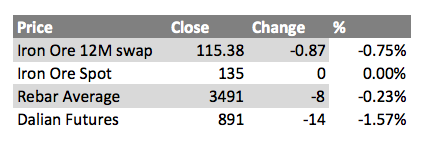Iron market chart for 6th Jan 2014

So it looks like the rest of the market is catching up with the 12M swap price roll over as supply returns.
That restricted supply has been seen in the freight market which looks to be returning to normal.
Capesize iron ore freight rates trended down Friday in a quiet and bearish market as few cargos were seen out of both West Australia and Brazil, and the paper market remained steeply backwardated.
Platts assessed the Capesize iron ore freight rate at $10.75/wmt on the West Australia to Qingdao route Friday, down 50 cents from Thursday and also down $1.75/wmt on the week.
There was unconfirmed talk of vessels being offered at around $11/wmt but fixture activity was weak with few cargoes seen in the market in the wake of Cyclone Christine earlier this week.
Market activity is expected to intensify next week as more market participants return from their year-end holidays, but the market is also braced for more bad weather.
“There will perhaps be more inquiries out of West Australia next week,” a Chinese trading source said.
Although North Chinese ports still face some congestion, an expanding tonnage list out of West Australia is expected to pressure freight rates on this route next week.
Long term, however, it’s all about the upcoming supply uplift.
Rio Tinto (RIO) is bullish about iron ore demand in China, which imports around 70% of the seaborne iron ore. To meet this demand, the company is increasing its production. It will increase its production capacity to 290 million metric tons by the first half of 2014 from 260 million metric tons currently, and will add another 40 million metric tons by 2015.
Other Australian miners — BHP Billiton (BHP), and Fortescue Metals Group Limited are also increasing iron-ore production. BHP expects to produce 212 million metric tons next year and is clearing bottlenecks to raise its export capacity to 270 million metric tons. Fortescue is projecting to produce at a rate of 155 million metric tons per annum by March 2014. Along with these Australian miners, Vale SA (VALE) will increase its production by 50% by 2018.
The latest data out of China suggests the economy is beginning to see slower growth as Xi Jinping’s reforms take hold. It is therefore possible that the producers are being overly optimistic in the demand predictions for the next 12-24 months.